

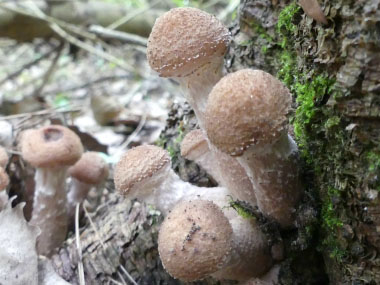
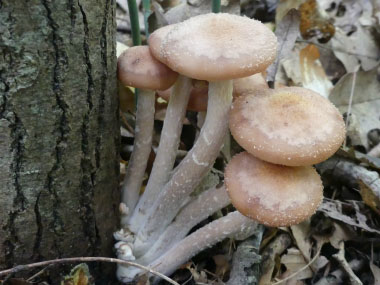
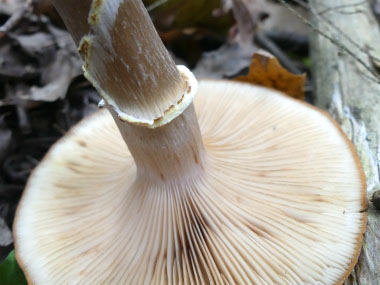
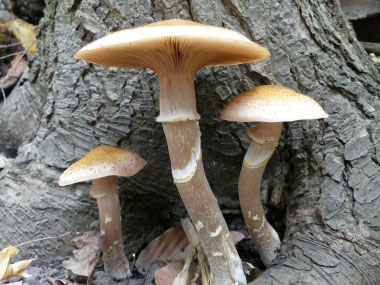
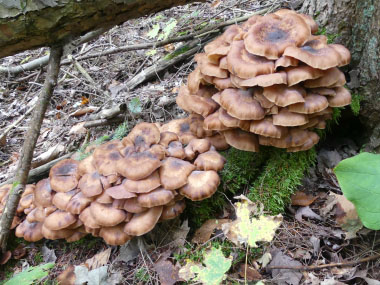
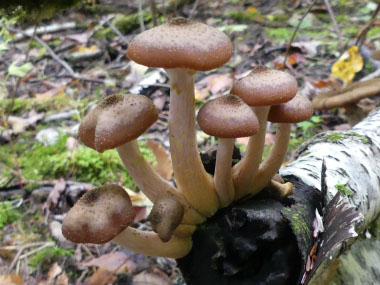
Do not eat any fungi that has not been properly identified by a qualified professional, some are DEADLY when ingested. All edible wild fungi MUST be cooked.
There are many forms of honey mushrooms, and in some books they are all given the scientific name Armillaria mellea even though it is now accepted that there are several distinct Armillaria species. This species was first described in 1790 by the Danish mycologist Martin Vahl (1749 - 1804), who named it Agaricus mellea. Honey Fungus was moved into its present genus in 1871 by the famous German mycologist Paul Kummer, whereupon its scientific name became Armillaria mellea. Armillaria mellea is the type species of the genus Armillaria. It is similar to Armillaria ostoyae.
Type
Distinguishing Features
When young, the stems are white, turning yellow or yellowish-brown and finely woolly as the fruitbody matures. The cap measures anywhere from 5 to 15cm in diametre; and the colour ranges from honey-yellow to red-brown, with a darker area near the centre. The cap flesh is white and firm. The cap, initially deeply convex, flattens and often develops wavy, striate margins. Fine scales cover the young caps, most noticeably towards the centre.
Height
Honeys can grow between 7 and 20 cm; 0.5 to 2 cm thick; equal above, but tapering to base due to the clustered growth pattern. The stem is fairly tough; often bald at maturity, but with whitish to pastel yellow flocculence from the veil when young.
Habitat
Honey mushrooms are parasitic on or up against broadleaf trees, including fruit trees in orchards; also occurring as a saprobe on stumps and dead roots and occasionally on fallen branches. They prefer forest settings.
Spore Print
Creamy white.
Season
Honey mushrooms can occur as early as late July although they are most common in September and October. They can grow well into November.
Gills
The adnate or more often weakly decurrent gills are crowded and flesh coloured, gradually becoming yellowish and finally developing rusty spots at maturity.
Edibility
Typically young caps are best to eat (must be cooked). Stems are fibrous making edibility a challenge. The best time to gather honeys to eat is while the veil is still attached (whole or in part) to the stipe (stem). Once the cap opens, the mushroom becomes more watery and brown – this may cause stomach upset in some people! Always fully cook caps when young.
Other Name
Honey Fungus.
Recipes
To support our efforts please browse our store (books with medicinal info, etc.).
Winter Survival Food Handbook

PDF Plant Magazines
Types of Wild Food
Geographic Zones Seasons
Disclaimer
EdibleWildFood.com is informational in nature. While we strive to be 100% accurate, it is solely up to the reader to ensure proper plant identification. Some wild plants are poisonous or can have serious adverse health effects.
We are not health professionals, medical doctors, nor are we nutritionists. It is up to the reader to verify nutritional information and health benefits with qualified professionals for all edible plants listed in this web site. Please click here for more information.
Why Edible Wild Food?
- Food costs are rising
- Free, wild food is readily abundant
- Wild food adds nutrition to your diet
- Wild food can help treat various medical conditions





